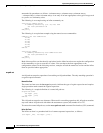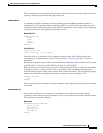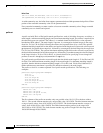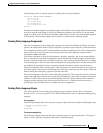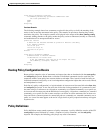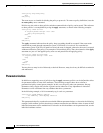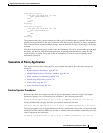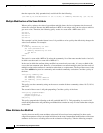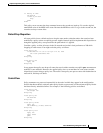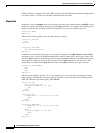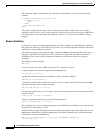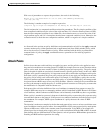
Implementing Routing Policy on Cisco IOS XR Software
Information About Implementing Routing Policy
RC-216
Cisco IOS XR Routing Configuration Guide
then the expression, fully parenthesized, would look like the following:
((not med eq 10) and destination in (10.1.3.0/24)) or community matches-any ([10..25]:35)
Multiple Modifications of the Same Attribute
When a policy replaces the value of an attribute multiple times, the last assignment wins because all
actions are executed. Because the MED attribute in BGP is one unique value, the last value to which it
gets set to wins. Therefore, the following policy results in a route with a MED value of 12:
set med 9
set med 10
set med 11
set med 12
This example is trivial, but the feature is not. It is possible to write a policy that effectively changes the
value for an attribute. For example:
set med 8
if community matches-any cs1 then
set local-preference 122
if community matches-any cs2 then
set med 12
endif
endif
The result is a route with a MED of 8, unless the community list of the route matches both cs1 and cs2,
in which case the result is a route with a MED of 12.
In the case in which the attribute being modified can contain only one value, it is easy to think of this
case as the last statement wins. However, a few attributes can contain multiple values and the result of
multiple actions on the attribute is cumulative rather than as a replacement. The first of these cases is the
use of the additive keyword on community and extended community evaluation. Consider a policy of
the form:
route-policy community-add
set community (10:23)
set community (10:24) additive
set community (10:25) additive
end-policy
This policy sets the community string on the route to contain all three community values: 10:23, 10:24,
and 10:25.
The second of these cases is AS path prepending. Consider a policy of the form:
route-policy prepend-example
prepend as-path 2 3
prepend as-path 666 2
end-policy
This policy prepends the following to the AS path (666 666 2 2 2). This prepending is a result of all
actions being taken and to AS path being an attribute that contains an array of values rather than a simple
scalar value.
When Attributes Are Modified
A policy does not modify route attribute values until all tests have been completed. In other words,
comparison operators always run on the initial data in the route. Intermediate modifications of the route
attributes do not have a cascading effect on the evaluation of the policy. Take the following example:



